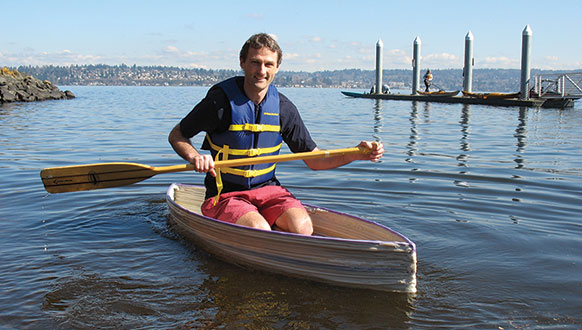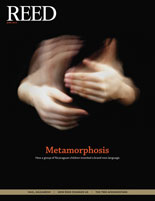
IRIS login | Reed College home Volume 92, No. 2: June 2013
Garbage and Gutenberg

Can 3-D printers help impoverished communities?
By Juliette Guilbert ’89
I made my 11-year-old daughter paddle the boat first. Cowardly, yes—but her summer-camp credentials are a lot more current than mine. After she expertly maneuvered the tiny plastic canoe around the shallows of Lake Washington, I was shamed into giving it a go. Matt Rogge ’97, a rangy fellow whose easy grin and intense blue eyes make him look more like a river guide than an engineering student, made encouraging noises and did his best to keep me from upending into the drink.
I wobbled till the icy water of the lake threatened to slosh over the gunwales. It was a tippy, leaky little vessel, about a quarter the size of any canoe I’d ever seen before. But, to be fair, it did start life as a truckload of plastic milk jugs. Matt chopped them up and fed them to Big Red, the 3-D printer he helped design and build, and Big Red extruded yards and yards of plastic filament into the shape of a canoe. Then he paddled the boat to second place in Seattle’s 2012 Seafair Milk Carton Derby (over the strenuous objections of derby purists).
What excited Matt most wasn’t the Cinderella story of the boat race, though. It was the fact that he’d turned a truckload of garbage into something useful—a goal he’d been chasing since signing up for a postbaccalaureate degree in mechanical engineering at the University of Washington, at age 37. In a way, though, the journey began three weeks after his Reed graduation, when he’d reported to his Peace Corps posting in Ghana, ready to try his hand at teaching science.
It didn’t take long for him to notice that his new community had more basic needs—and to remake himself as a budding water engineer. “It was a town with 2,000 people and only one quality water source,” he says. “So I shifted into hand drilling wells and building pumps. It took some convincing to get out of the classroom.”
Matt enjoyed the hands-on work. At Reed, he’d majored in chemistry, writing a thesis under professor Maggie Geselbracht [chemistry 1993–], an experience he describes as empowering. “The thesis was huge,” he says. “It encourages experimentation. You want to figure out how to do something? Go ahead and do it. You’re encouraged to be creative, and you don’t get stomped when you come up with an idea that’s a little on the outside.”
At the same time, though, chemistry didn’t always satisfy his desire to get his hands dirty. “In chemistry, you can’t even see the things you’re trying to control,” he says. For more immediate gratification, he turned to art, fast-talking his way into a sculpture class with Lea Black [art 1989–94] as a freshman (you were supposed to take painting first) and then taking sculpture all four years at Reed.
In Ghana, building pumps gave Matt the sensory gratification of sculpture, together with the more abstract challenges of backcountry engineering. “I’d figure something out, and then boom—there’s a working pump where there wasn’t one before.” But trying to build infrastructure in a poor, remote community of the world was also frustrating. If a pump failed because of a 50-cent part, the cost of shipping a replacement part from Europe could be 10 times that amount. Often, the only solution was to fabricate the parts out of plastic himself—a difficult and time-consuming task.
During a second Peace Corps stint in Bolivia and Panama (this time with his wife, Alicia Ashby ’00), the challenges were the same. He was signed up to design and build gravity-flow water systems—“lots of ditch digging”—but again, there was a constant shortage of crucial parts and no local manufacturing base to make them.
“Then I read about 3-D printing,” Matt says. “And I immediately knew that’s what I wanted to work on.”
3-D printers lay down strips of plastic filament to construct three-dimensional objects—ranging from DIY art projects to industrial prototypes. What if people in remote areas could just print some of the things they needed? From small items like those pesky pump parts to big stuff, like latrines, seeders, even (yes, we admit this is weird) more 3-D printers?
The problem was finding a printer that could meet the needs of remote communities. There were powerful, expensive industrial models that cost $15,000 and up—out of reach for a poor village. And there were the cheap ones used by hobbyists—$300 or less, but too small to get the job done and dependent for their feedstock on plastic filament that cost $20 a pound. The printer of his dreams was big, powerful, and cheap. It could print large objects using waste plastic, not expensive filament. And it didn’t exist.
So, just as he’d built fabricated spare parts for his water pumps and lab equipment for his chemistry students, Matt set out to build himself a printer. At UW, he founded a 3-D printing club, Washington Open Object Fabricators (WOOF), teamed up with two like-minded budding engineer undergrads, and got down to it. That’s when he met a leggy red 4 feet × 8 feet plasma cutter that was struggling to grow up into a working 3-D printer.
Other student groups had worked on Big Red before—four, to be exact—but nobody had gotten it to print in 3-D. “They could never make an extruder that worked, and they couldn’t get the software to work,” Matt says. “It was stuck in two-dimensional space.” Big Red’s Greenlake coming-out party was proof that one could build a 3-D printer that combined power, flexibility, and cheapness. Matt seems most excited about the cheapness.
“Filament for the boat would have cost $800,” he says. “If we’d bought the plastic milk bottles, instead of getting them for free, it would have cost about $3.20.”
After the derby, things went into high gear. In October, his team won $100,000 in the 3D4D Challenge, a competition sponsored by the charity techfortrade to promote the use of 3-D printing to improve life in the developing world. This summer, after graduating, he’ll head to Oaxaca to put the technology to use work in the real world.
“It’s pretty exciting and somewhat scary,” he says. “We’re going into totally uncharted territory. The big question is whether we can make things people consider useful.”
The demand is out there. A story in the Economist about the 3D4D contest led to calls from around the world. “People were asking if we could provide them with printers to make boats,” he says, “so they could stop cutting down their old-growth forests.” But Matt and his partners want to start a self-sustaining business, not an NGO, and the path to a working business model isn’t entirely clear yet.
“From my experience in the Peace Corps, if we just brought machines down and set them loose, they’d go to the scrap pile within a year,” he says. “So we want to build a shop that makes printers. That way [the locals] have the capacity. And I’d like to start leasing printers—a couple of 3-D printers might provide some income.”
At the same time, he’s working on refining the technology further. Big Red was built from a repurposed machine for cutting metal in three dimensions; now the team is developing a a Big Red-style sprinter from the ground up. (He estimates the cost at $1,000 for parts, with about two days’ labor). Matt and his partners plan to build printers in a few different sizes for different uses. They’ve designed and built a low-cost machine that creates that pricey plastic filament from waste. And shortly before we met at the lake, Matt had used Big Red to print two-thirds of a toilet (the job failed partway), which he proudly displayed from the back of his SUV.
About to head off for a spring break trip to Oaxaca to network and connect with NGO partners, Matt was bursting with ideas and enthusiasm about recycling, water, and sanitation, and what he might eventually be able to print: low-smoke wood stoves, affordable seeders, cheap LED headlamps, maybe even an entire water pump printed from scratch. “It’s misleading to say you can print anything,” he cautions. But, the gleam in his eye seems to say, that doesn’t mean you can’t try.
“A lot of people said this would never work, that we were crazy,” he says. “After we printed the boat and paddled it around Green Lake, I found a web page that was just a list of why you can’t print large-scale objects. I’m glad I didn’t read that until afterward.”
“But would that have stopped you from trying it?” I asked.
“No,” he said, grinning. “I don’t think so.”

LATEST COMMENTS
steve-jobs-1976 I knew Steve Jobs when he was on the second floor of Quincy. (Fall...
Utnapishtim - 2 weeks ago
Prof. Mason Drukman [political science 1964–70] This is gold, pure gold. God bless, Prof. Drukman.
puredog - 1 month ago
virginia-davis-1965 Such a good friend & compatriot in the day of Satyricon...
czarchasm - 4 months ago
John Peara Baba 1990 John died of a broken heart from losing his mom and then his...
kodachrome - 7 months ago
Carol Sawyer 1962 Who wrote this obit? I'm writing something about Carol Sawyer...
MsLaurie Pepper - 8 months ago
William W. Wissman MAT 1969 ...and THREE sisters. Sabra, the oldest, Mary, the middle, and...
riclf - 10 months ago